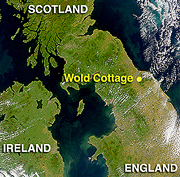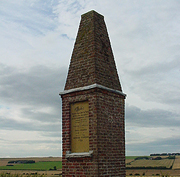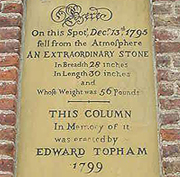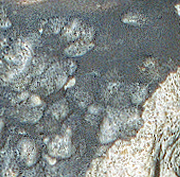Official Name:
This meteorite is not named for the village where it fell, but for the farmhouse closest to the fall. Another name is sometimes used: Yorkshire, from the name of the region where the fall occurred.
Location:
The meteorite fell one kilometre southwest of the church in Wold Newton, Yorkshire, England.

Enlargement
The Wold Cottage meteorite fell in the county of Yorkshire, England. |
|
|
Fall or Find:
Fall
Date:
13 December 1795, 3:30 p.m. local time.
Mass Recovered:
25.4 kilograms
Number of Fragments:
A single fragment was found. It measures 25 centimetres wide by 30 centimetres long.
Crater:
The meteorite plunged 65 centimetres into the muddy soil. The crater created was almost one metre in diameter.
Circumstances:
Explosions that sounded like canon shots were heard in the neighbouring villages. Several witnesses near the site of the fall saw a dark object passing through the clouds. A farmhand was standing so close to the impact site that he was splashed by mud! Helped by other workers, he dug down to free the stone. When they got it out, the meteorite was still warm and smelled of sulphur. In the following weeks, many curious visitors travelled to Wold Cottage to see the stone.
History:
In 1799, Mr. Edward Topham, owner of the land, had a commemorative monument erected at the exact spot the meteorite landed. The column still stands on the land that belongs to Wold Cottage.

Enlargement
Monument erected by Magistrate Edward Topham at the exact spot where the meteorite landed. |
|

Enlargement
Close-up of the commemorative plaque on the monument. |
|
Type:
Stony meteorite
Class:
Ordinary chondrite
Group:
L6

Enlargement
The main mass of the Wold Cottage meteorite is on display at the Natural History Museum in London. |
|
Composition:
This meteorite has a low iron content. Its chondrules are scattered and poorly defined. A cut of the meteorite reveals a linear internal structure indicating metamorphism. This chondrite came from a parent-body that was slightly altered.
Scientific contribution:
Wold Cottage was one of the first meteorites to be studied scientifically. At the beginning of the nineteenth century, British chemist Edward C. Howard analyzed Wold Cottage and three other suspect rocks from elsewhere in the world. His study confirmed the extraterrestrial origin of the rocks, in particular through the presence of nickel in each specimen and the large difference between the rocks' mineral composition when compared to known terrestrial rocks.
The many witnesses to this meteorite fall also helped advance the idea of rocks falling from the sky. Topham documented the fall, methodically gathering and corroborating the accounts of his employees and those of the villagers.
Comments:
The Wold Cottage meteorite is the second largest fall in England. It is the oldest fall in England for which written accounts and samples of the meteorite still exist today.
Part of the Planétarium's collection:
Yes